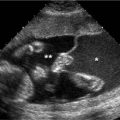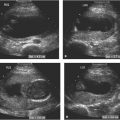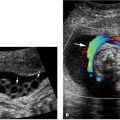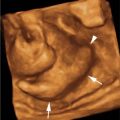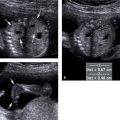Fetal Anatomy
2.1. Head
Description and Clinical Features
By the beginning of the second trimester, the fetal cranium and brain are well formed, although the skull will continue to ossify and the brain will undergo extensive growth and development during the second and third trimesters. In particular, the bones of the skull grow and ossify throughout gestation, but the sutures and fontanelles do not close until several months after birth. The cerebral hemispheres undergo rapid growth in the third trimester and, toward term, develop multiple sulci and gyri that increase the brain’s surface area to provide room for a large number of neurons. Measurements of the fetal head are used to assess gestational age and fetal growth.
Sonography
On second- and third-trimester sonography, the fetal cranium and its contents are primarily evaluated using three key images: (i) the biparietal diameter (BPD) measurement view, (ii) an image demonstrating the lateral ventricles, and (iii) one showing the posterior fossa. The BPD view is an axial scan at the level of the paired thalami, the midline falx, and the cavum septum pellucidum. The BPD is measured on this image by placing the calipers on the leading edges of the cranium (Figure 2.1.1). The occipitofrontal diameter is measured on the same view, from the middle of the cranium frontally to the middle occipitally (Figure 2.1.1). On this view, the head circumference can also be measured using the electronic ellipse function to trace the outer contour of the cranium (Figure 2.1.2).
Important intracranial structures are identified on the BPD view, including the thalami, falx, third ventricle, and cavum septum pellucidum (Figure 2.1.1). The third ventricle is normally a narrow slit of fluid between the heart-shaped, paired thalami. The cavum septum pellucidum is a square- or rectangular-shaped fluid space, anterior to the thalami, located between the frontal horns of the lateral ventricles. The falx is a linear bright echo in the midline anterior to the cavum septum pellucidum, separating the cerebral hemispheres.
The lateral ventricles and choroid plexuses are assessed on an axial view of the head at the level of the occipital horns and atria of the lateral ventricles. The measurement of the lateral ventricle is taken by placing calipers across the ventricle at the atrium, near the posterior tip of the choroid plexus, perpendicular to the axis of the lateral ventricle (Figure 2.1.3). The normal lateral ventricle measures 10 mm or less at the atrium.
Axial views of the posterior fossa allow assessment of the cerebellum, fourth ventricle, and cisterna magna. The normal cerebellum has a posterior contour like the side of a peanut, with hypoechoic, rounded, cerebellar hemispheres on either side of the narrower, more echogenic, cerebellar vermis (Figure 2.1.4). The cisterna magna, the fluid space between the vermis and the occipital bone (Figure 2.1.5), normally measures less than 10 mm in anteroposterior dimension. When evaluating the cisterna magna, care must be taken to image it in a near-axial plane with very slight coronal angulation. If the image plane is angled coronally more than approximately 15 degrees, the cisterna magna may appear artificially enlarged to greater than 10 mm (Figure 2.1.6). The fourth ventricle is a small fluid space located anterior to the cerebellar vermis and posterior to the midbrain (Figure 2.1.7).
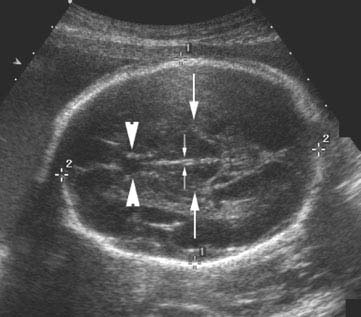
Figure 2.1.1
Biparietal and occipitofrontal diameter measurements. Axial view of the fetal head, at the level used for measurement of the biparietal diameter, demonstrates the paired thalami (large arrows) with the slitlike third ventricle between them (small arrows), and the cavum septum pellucidum (arrowheads). The falx is the linear bright echo in the midline anterior to the cavum septum pellucidum, separating the cerebral hemispheres. The + calipers labeled “1” are placed on the leading edge of the cranial bone at the near and far sides of the skull (i.e., on the external aspect of the near side and the internal aspect of the far side) to measure the biparietal diameter. The + calipers labeled “2” are placed in the middle of the visible cranial bone anteriorly and posteriorly to measure the occipitofrontal diameter.
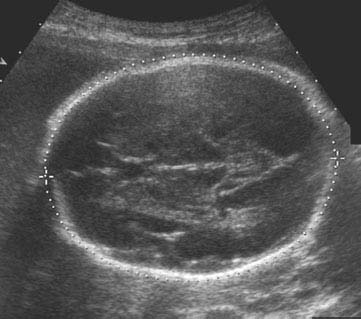
Figure 2.1.2
Head circumference measurement. On an image at the same level as that used to measure the biparietal diameter, the head circumference is measured with electronic ellipse calipers (+ … +) around the outer rim of the ossified cranium.
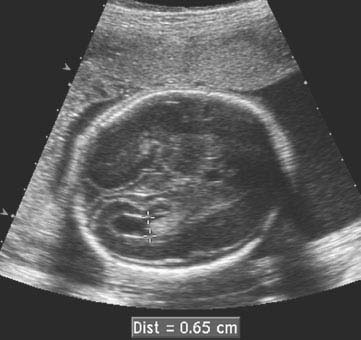
Figure 2.1.3
Lateral ventricular measurement. Axial view of the head demonstrating measurement of the width of the lateral ventricle at the level of the atrium, with + calipers placed on the ventricular wall.
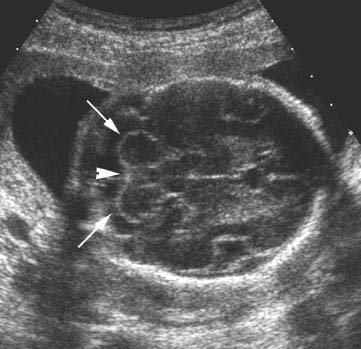
Figure 2.1.4
Cerebellum. Axial view of the posterior fossa demonstrating the contour of the normal cerebellum, with rounded cerebellar hemispheres (arrows) on either side of the more echogenic vermis (arrowhead).
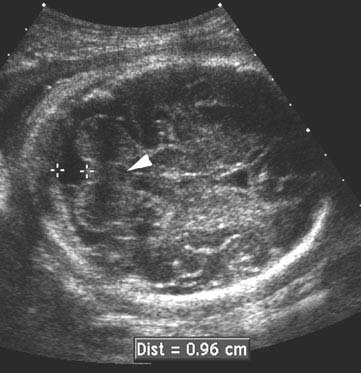
Figure 2.1.5
Cisterna magna and fourth ventricle. Axial view of the posterior fossa demonstrating the fluid-filled cisterna magna (+ calipers) and the location of the fourth ventricle (arrowhead).
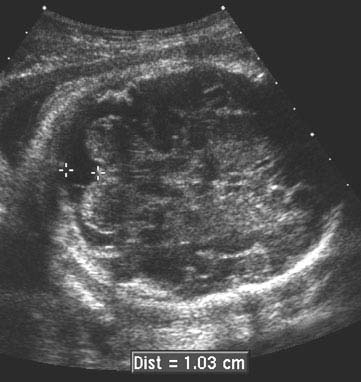
Figure 2.1.6
Pseudo megacisterna magna. Steeply angled axial view of the posterior fossa in the same fetus as Figure 2.1.5 falsely enlarges the width of the cisterna magna (+ calipers) to greater than 10 mm.
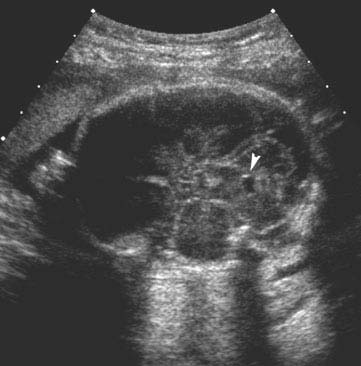
Figure 2.1.7
Fourth ventricle. Axial image of posterior fossa demonstrating a small amount of fluid in the fourth ventricle (arrowhead).
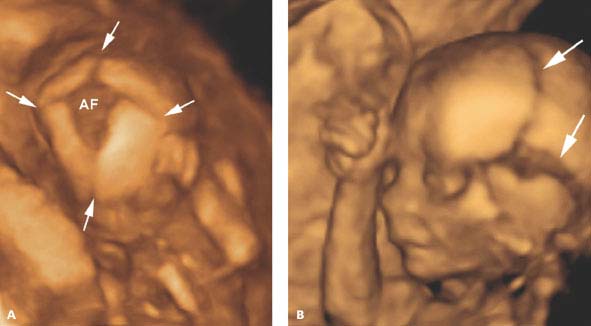
Figure 2.1.8
Cranial bones. A: Three-dimensional (3D) ultrasound with skeletal settings demonstrating the cranial bones surrounding the anterior fontanelle (AF) of an 18-week fetus. The sutures (arrows) between the bones appear as dark lines between the brighter bones. B: 3D image demonstrating cranial sutures (arrows) on one side of the head.
The bones of the skull can be assessed with three-dimensional (3D) ultrasound, using skeletal settings to distinguish ossified portions of the cranium from sutures and fontanelles (Figure 2.1.8).
2.2. Face
Description and Clinical Features
The face is well formed by the beginning of the second trimester, such that the orbits and lenses of the eyes, ears, nose, and mouth are readily recognizable. During the latter half of pregnancy, the soft tissues of the face thicken to fill out the cheeks and chin.
Sonography
With two-dimensional (2D) ultrasound, the fetal face is assessed in sagittal, coronal, and transverse views. The presence and position of the orbits and globes are best evaluated on transverse or coronal images (Figure 2.2.1). On a coronal view, the nose and lips are well seen (Figure 2.2.2). Sagittal views of the face demonstrate the mandible, maxilla, and nasal bones, as well as the soft tissues overlying these bones (Figure 2.2.3). With 3D ultrasound, the soft tissues of the face are better appreciated, including the eyes, nose, and lips (Figure 2.2.4) and the ears (Figure 2.2.5).
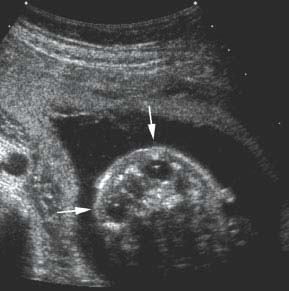
Figure 2.2.1
Orbits. Coronal images through face demonstrating both orbits (arrows). The lens of each eye is seen as a small bright oval in each globe.
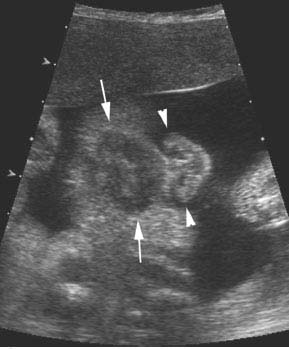
 Figure 2.2.2
Figure 2.2.2
Nose and lips. Coronal view of lower face demonstrating the upper and lower lips (arrows) and the contour of the nose with both nostrils (arrowheads).

Figure 2.2.3
Facial profile. Sagittal view shows the soft tissues of the face overlying the echogenic bones that support it, including the nasal bone (arrow).
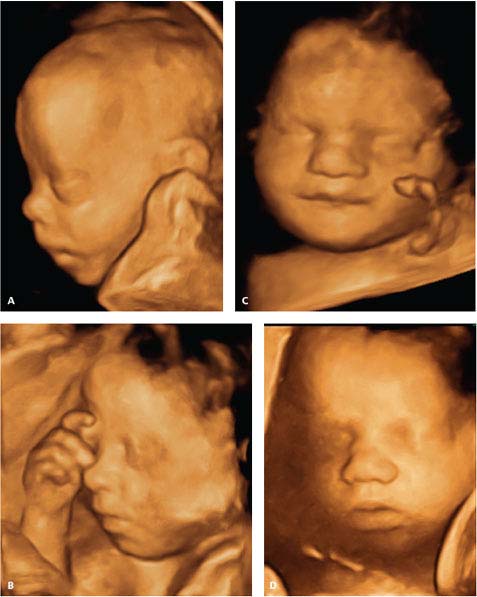
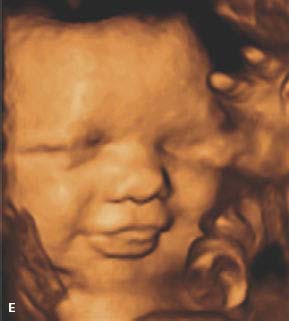
Figure 2.2.4
Three-dimensional (3D) face. 3D images of the face at (A) 22 weeks, (B) 26 weeks, (C) 31 weeks, (D) 35 weeks, and E38 weeks.
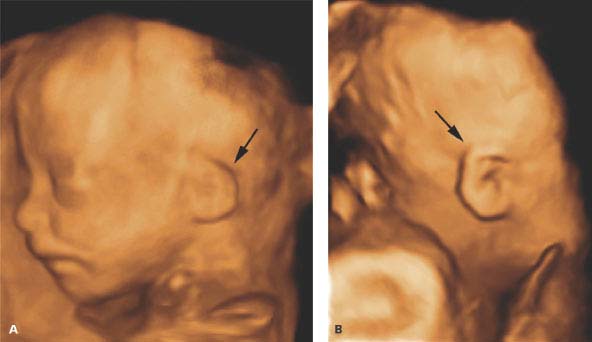
Figure 2.2.5
Ear. A: Three-dimensional (3D) ultrasound of a 20-week fetal face viewed from the left side demonstrating the facial profile and the ear (arrow). B: 3D ultrasound at 31 weeks demonstrating more detail to the structure of the ear (arrow) than at 20 weeks.
2.3. Spine
Description and Clinical Features
Each vertebra of the spine is formed with three ossification centers: a central ossification center that will become the vertebral body and two posterior ossification centers that will become the laminae and pedicles. During the second and third trimester, the ossifications centers continue to ossify, providing a bony canal encircling the spinal cord.
Sonography
The fetal spine should be assessed from the cervical spine through the sacrum in both longitudinal and transverse planes. The three ossification centers of each vertebra are brightly echogenic. The central ossification center, which forms the vertebral body, is located midline and anterior to the two posterior ossification centers.
The three ossification centers at each level can be seen on transverse view. The two posterior ossification centers angle toward one another as they extend posteriorly (Figure 2.3.1), toward the skin surface. On longitudinal views, the ossification centers are aligned in parallel until they converge at the lower sacrum (Figure 2.3.2). Only two of the three ossification centers can be seen on a longitudinal image. On a sagittal image, the central ossification center and one posterior ossification center are visualized for each vertebra. On a coronal image, both posterior ossification centers are seen at each level. There should be a one-to-one correspondence between ossification centers on either view. The spine should be straight from side to side and have a normal thoracic kyphosis and lumbar lordosis.
With 3D ultrasound, using settings to display the bones of the fetus, the spine can be imaged showing all the ossifications centers (Figure 2.3.3). The ribs can be seen on each side of each thoracic vertebra (Figure 2.3.4).
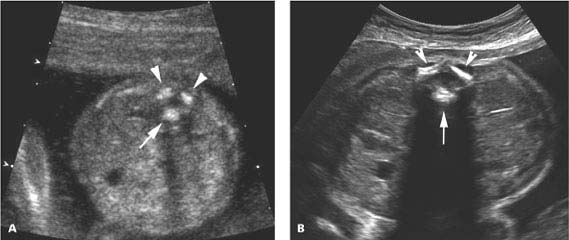
 Figure 2.3.1
Figure 2.3.1
Spine. A: Transverse view of an upper lumbar vertebra at 18 weeks of gestation demonstrating its three ossification centers, two posterior (arrowheads) and one anterior (arrow). Skin covers the spine posteriorly. B: By 30 weeks, the posterior (arrowheads) and anterior (arrow) ossification centers are much more ossified, encircling the spinal canal.
Stay updated, free articles. Join our Telegram channel

Full access? Get Clinical Tree


